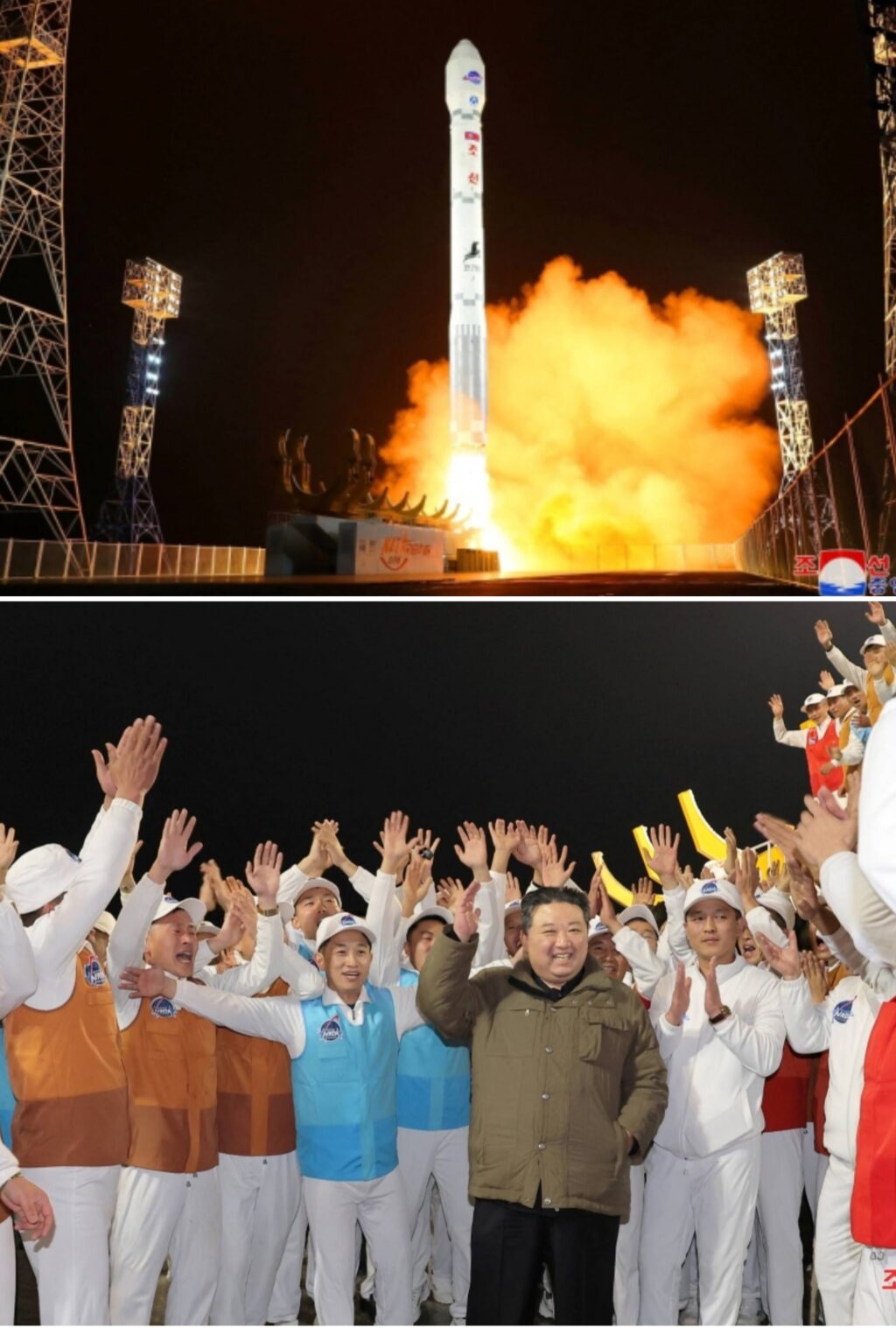North Korea claimed to have successfully launched a spy satellite

North Korea said early Wednesday it had successfully placed its first military spy satellite into orbit, state-run media reported A rocket carrying a payload passed over the Japanese archipelago late Tuesday, drawing strong condemnation from Tokyo .
However, Japanese officials said Tokyo was continuing to analyze the launch – Pyongyang’s third attempt this year to put a spy satellite into orbit – but could not immediately determine whether the rocket launch or the satellite mission was successful. . The Pentagon also said it was still assessing whether the launch was successful.
South Korea, meanwhile, said Wednesday that it would partially suspend a landmark 2018 inter-Korean military agreement in response, and resume reconnaissance and surveillance activities around the border.
“North Korea is clearly demonstrating that it has no will to abide by the Sept. 19 military agreement designed to reduce military tension on the Korean Peninsula and to build trust,” the Yonhap news agency quoted South Korean Prime Minister Han Duk-soo as saying following a Cabinet meeting.
The North characterized the launch — overseen by leader Kim Jong Un — as a “legitimate” move aimed at bolstering its “self-defense capabilities” and said the country would launch additional satellites “in a short span of time,” the official Korean Central News Agency reported.
“The carrier rocket ‘Chollima-1’ flew normally along the preset flight track and accurately put the reconnaissance satellite ‘Malligyong-1’ on its orbit at 22:54:13, 705s after the launch,” the report said.
Since 1998, the North has now attempted seven satellite launches, with just two — not including the latest — appearing to have been successfully placed in orbit, the last in 2016.
Observers routinely urge caution in taking North Korea’s claims at face value, since the regime has a long history of embellishing its accomplishments, especially in the military arena.
Success or not, Japan’s top government spokesman, Chief Cabinet Secretary Hirokazu Matsuno, criticized North Korea’s “unprecedented” spate of missile tests over nearly two years, but said Tuesday’s launch was a different page in Pyongyang’s well-worn playbook.
“In addition to the series of provocative actions that have continued at a high frequency, this latest launch — which passed over the Japanese archipelago — poses an even more serious and imminent threat to Japan’s national security, as well as that of the region, and is a serious challenge to the international community as a whole,” he told a news conference early Wednesday.
While the government had not received any reports of harm or damage, Matsuno said that the launch, which came despite repeated calls for Pyongyang to halt its preparations, had endangered the safety not only of aircraft and ships, but also of residents in the vicinity since the rocket had separated into two parts after it was fired from North Korea’s Tongchang-ri area, home to its Sohae Satellite Launching Station.
Matsuno said the first part of the rocket had fallen into the East China Sea, some 350 kilometers west of the Korean Peninsula. The second part, he said, had passed between Okinawa Prefecture’s main island and the island of Miyako — briefly triggering Japan’s J-Alert warning system for residents to take shelter — before splashing down some 1,200 kilometers southwest of Okinotori Island, a remote atoll in an area of the Pacific far outside of Japan’s exclusive economic zone.
Speaking to reporters at his office in Tokyo just before midnight, Prime Minister Fumio Kishida condemned the launch “in the strongest possible terms,” calling it “a serious situation that concerns the safety of our nation’s citizens.”
Kishida said Japan was working to gather information and would respond in cooperation with the United States and South Korea.
“Even if (the launch) was called a satellite, it used ballistic missile technology,” he said. “This is a clear violation of United Nations Security Council resolutions.”
Pyongyang is prohibited from conducting ballistic missile launches under United Nations Security Council resolutions, but has in the past said these measures do not cover its nominally civilian space program. Japan, South Korea and the U.S., however, view the launch of satellites as a thinly veiled means of advancing its missile program, since similar technology is employed.
The White House also condemned the launch, which it said used ballistic missile technology, calling it “a brazen violation of multiple U.N. Security Council resolutions” that “raises tensions and risks destabilizing the security situation in the region and beyond.”
“This space launch involved technologies that are directly related to the DPRK intercontinental ballistic missile program,” White House National Security Council spokesperson Adrienne Watson said in a statement, adding that the U.S. would “take all necessary measures” to ensure its security and that of its South Korean and Japanese allies.
Washington also delivered an apparent signal to China and Russia, the North’s main backers, while hinting that it was still open to talks with Pyongyang.
“We urge all countries to condemn this launch and call on the DPRK to come to the table for serious negotiations,” the White House said, using the acronym for the North’s formal name. “The door has not closed on diplomacy but Pyongyang must immediately cease its provocative actions and instead choose engagement.”
The launch came ahead of a window announced earlier Tuesday that would have seen it fired between Wednesday and Dec. 1, with Pyongyang brushing away warnings from Tokyo and Seoul not to go ahead with the move.
It was not immediately clear why the North had conducted the launch earlier, but rain and a Wednesday forecast of cloudy weather for parts of the isolated country may have pushed it forward.
In the days ahead of the launch, Tokyo and Seoul had demanded that the North immediately halt preparations for firing the rocket.
KYODO
Tokyo had deployed countermeasures in preparation for a potential shootdown of the rocket or debris, sending PAC-3 ground-based missile-defense batteries to Okinawa’s Miyako, Ishigaki and Yonaguni islands, while also deploying Maritime Self-Defense Force Aegis destroyers — which are equipped with SM-3 interceptors — to waters around Japan.
Separately Tuesday, the nuclear-powered USS Carl Vinson aircraft carrier arrived at the South Korean naval base in the port city of Busan in a show of allied force ahead of the launch.
South Korea said the arrival of the Vinson — the third aircraft carrier to visit the country this year — demonstrated Washington and Seoul’s “firm resolve to respond to advancing North Korean nuclear and missile threats.”
The latest launch comes after a period of relative quiet — the North last fired off a missile on Sept. 13 — though the country has continued to spew vitriol over Tokyo, Seoul and Washington’s growing trilateral security ties. That missile launch came just ahead of a visit to Russia by leader Kim Jong Un for talks with Russian President Vladimir Putin.
South Korea has said Pyongyang is providing Moscow with weapons in exchange for Russian space technology know-how. Putin suggested during his meeting with Kim that his country could help the North build satellites.
North Korea’s state-run media has called the country’s spy satellite program an “indispensable” measure to counter U.S. and allied space militarization.
The North has been seeking to put a military reconnaissance satellite into orbit as part of a broader modernization plan to monitor U.S. and allied forces, though defense experts say doing so can be exceedingly difficult.
Observers also say it’s unclear how advanced a North Korean satellite would be, considering the daunting challenges of camera performance, hard-to-come-by components and limited time windows for snapping shots of military sites.







